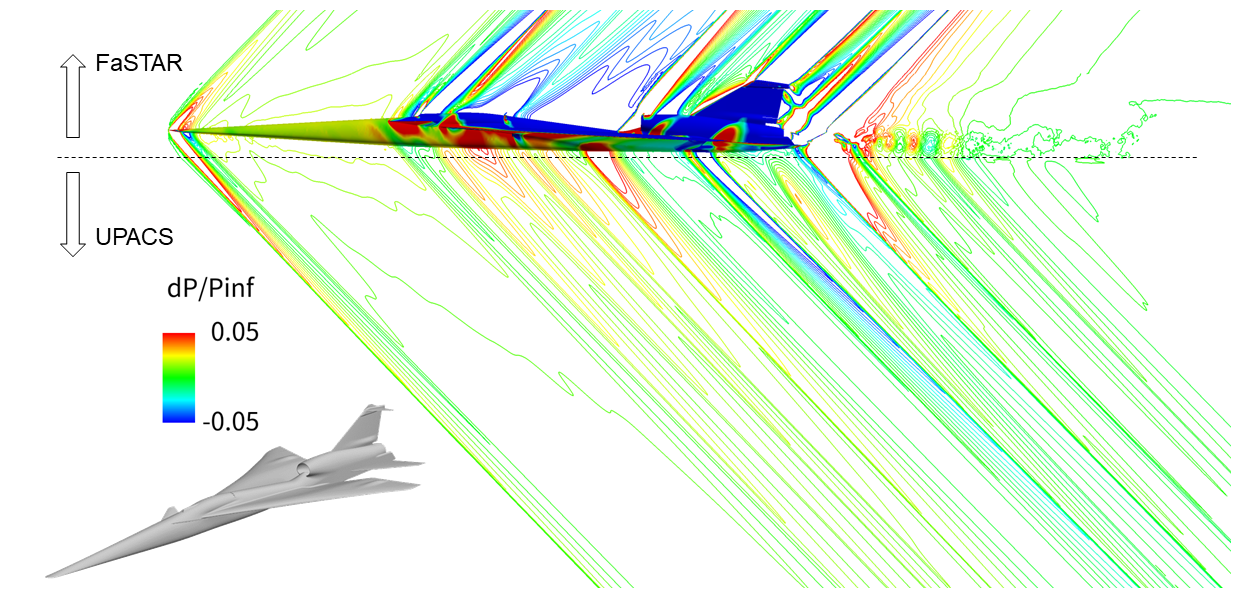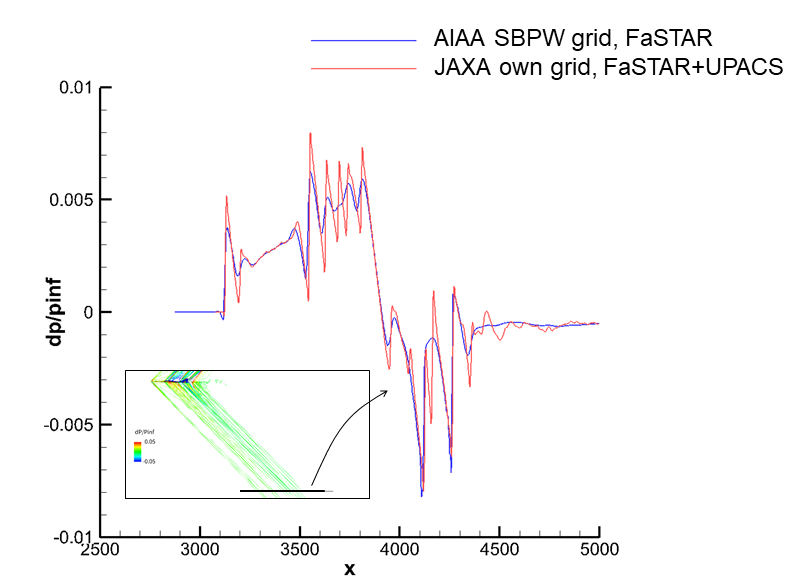Research and development for system integration of silent supersonic airplane technologies
JAXA Supercomputer System Annual Report April 2019-March 2020
Report Number: R19EA3800
Subject Category: Aeronautical Technology
- Responsible Representative: Yoshikazu Makino, Aeronautical Technology Directorate, Aviation Systems Research Unit
- Contact Information: Hiroaki Ishikawa(ishikawa.hiroaki2@jaxa.jp)
- Members: Junichi Akatsuka, Naoko Tokugawa, Hiroaki Ishikawa, Yoshikazu Makino, Dongyoun Kwak, Keisuke Ohira, Atsushi Ueno, Satoshi Kondo, Tatsunori Yuhara, Ryo Shimada, Shinya Koganezawa
Abstract
It is important to acquire world-class high level technology in order to enhance the international competitiveness of Japan’s aircraft manufacturing industry, especially for supersonic transport. In addition, the advantage is great, such as revitalizing economic activities from the business and tourism aspects by shortening the travel time of supersonic flight, and the health aspects of passengers such as suppression of economy class syndrome. Based on this, the purpose of this project is to acquire the key technologies required to realize a “quiet supersonic aircraft” and contribute to the development of the aircraft manufacturing industry and air transport in the future. In this project, R&D on sonic boom estimation, measurement and evaluation technologies will contribute to the formulation of international standards at ICAO required for over land supersonic flight. The integrated design technology that simultaneously satisfies both low boom, low drag, low noise and weight reduction are developed to present a concept of a supersonic transport that simultaneously satisfies these technical goals.
Reference URL
Please refer to ‘D-SEND project / Silent supersonic transport technology | Sky Frontier – Sky Frontier Program | Aeronautical Technology Directorate‘.
Reasons and benefits of using JAXA Supercomputer System
To develop a future supersonic transport that satisfies the requirement of low sonic-boom and low aerodynamic drag, it is necessary to estimate aerodynamic properties and sonic-boom properties by accurate numerical simulation. JSS is used to estimate aerodynamic performances of various configurations with high accuracy and high efficiency for the designing of the low-boom supersonic transport.
Achievements of the Year
The aerodynamic assessment of the designed configuration was performed by applying the CFD analysis with RANS equation under the actual flight condition simulating the engine exhaust condition in order to design under the condition close to the actual supersonic transport. This analysis clarified the influence of jet exhaust to the low sonic boom performance and designed the configuration to reduce the influence. It has been found that the CFD analysis used in the low-boom design has sufficient performance through the 3rd AIAA Sonic Boom Prediction Workshop (SBPW3) comparing with the other participants. Figure 1 shows the pressure distribution obtained by CFD analysis of the earlier version of NASA X-59 that was the subject of SBPW3, and Fig. 2 depicts the near field pressure signature of the sonic boom away from the 3-body length. It can be seen that the near-field pressure signature of the JAXA own grid captures more clearly than the given grid (Required grid).
Publications
– Peer-reviewed papers
Akatsuka, T., “Comparison of Prediction Methods on Jet Noise Shielding and Reflection Effects,” Aerospace Technology Japan, Vol.17, No.6, pp.597-602, 2019
– Invited Presentations
Naka, Y., Kanamori, M., Ishikawa, H., and Makino, Y., “Evaluation of sonic booms measured in D-SEND#2 flight test,” 178th Meeting of the Acoustical Society of America (ASA), 2019
– Oral Presentations
Suzuki, H., Ishikawa, H., and Ueno, A., “Optimal Trajectory of S4 for Reducing Sonic Boom Loudness,” Asia Pacific International Symposium on Aerospace Technology (APISAT), 2019
Akatsuka, J., and Ishii, T., “System Noise Assessment of NASA Supersonic Technology Concept Aeroplane Using JAXA’s Noise Prediction Tool,” AIAA Science and Technology Forum and Exposition (AIAA SciTech 2020) , 2020
Ishikawa, H., Koganezawa, S., and Makino, Y., “Near-fileld pressure signature prediction by JAXA,” 3rd AIAA Sonic Boom Prediction Workshop, 2020
Usage of JSS2
Computational Information
- Process Parallelization Methods: MPI
- Thread Parallelization Methods: Automatic Parallelization
- Number of Processes: 128 – 512
- Elapsed Time per Case: 20000 Second(s)
Resources Used
Fraction of Usage in Total Resources*1(%): 0.67
Details
Please refer to System Configuration of JSS2 for the system configuration and major specifications of JSS2.
| System Name | Amount of Core Time(core x hours) | Fraction of Usage*2(%) |
|---|---|---|
| SORA-MA | 5,420,559.09 | 0.66 |
| SORA-PP | 140,687.99 | 0.91 |
| SORA-LM | 11,683.91 | 4.88 |
| SORA-TPP | 0.00 | 0.00 |
| File System Name | Storage Assigned(GiB) | Fraction of Usage*2(%) |
|---|---|---|
| /home | 494.81 | 0.41 |
| /data | 15,139.93 | 0.26 |
| /ltmp | 9,082.04 | 0.77 |
| Archiver Name | Storage Used(TiB) | Fraction of Usage*2(%) |
|---|---|---|
| J-SPACE | 13.83 | 0.35 |
*1: Fraction of Usage in Total Resources: Weighted average of three resource types (Computing, File System, and Archiver).
*2: Fraction of Usage:Percentage of usage relative to each resource used in one year.
JAXA Supercomputer System Annual Report April 2019-March 2020




